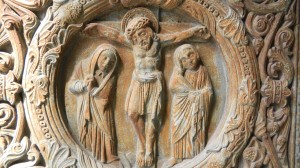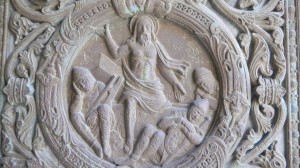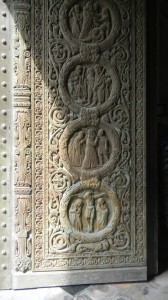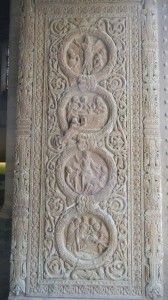The person who spearheaded Gothic style, Abbot Suger, personally provided the pair of bronze doors for the main entrance to the church of St. Denis.
The north door (on your left as you enter), has scenes of the Passion of Christ.
The south door has scenes of Christ’ Resurrection. There’s an important reason for this arrangement, and it’s one of the keys for appreciating Gothic style.
The rising sun’s position returns from the south in Spring, and thus during Easter. The architecture of the church thus corresponds with the seasons–with the larger universe. The church isn’t just an isolated building. The Gothic church represents the whole universe, as people in the 12th and 13th centuries saw it.
Above is the north door. Both doors were under the sculpture of the Last Judgment (see Gothic Style is Born, Part Two). So the entrance and the entire west facade which you enter through represent salvation. The emerging realism and artistic variety in Gothic style brought this key event in the Medieval universe to life.
And it did so with linear forms–both doors (the south one’s pictured above) portray scenes from the Crucifixion and Resurrection in a clear linear order that complements medieval Europe’s Christian-centered cosmology–one god, one savior. Christ’s life was the central narrative in history, and all history advances towards one goal–the City of God. Walking under the sculpture of the last judgment as you enter the church makes this clear–you’re proceeding towards history’s final goal, by His grace. This linear order is a very interesting contrast with the vast cycles in Indian art and thought.
But was the Gothic cosmic order so clear? Around the four scenes on each door, you see vegetal patterns that are so exuberant that they seem to want to burst through the clear lines and circles. Artists in the 12th and 13th centuries became increasingly skilled. They enjoyed portraying all of God’s vegetable and animal creations so much that their masters must have had to remind them to stay within the lines.
But Gothic style made both the spiritual and material worlds more realistic and compelling. As more churches were built, both became even more realistic.
So the entrance to the abbey church of St. Denis is more monumental than even Abbot Suger thought–it encouraged more realistic ways of showing both worlds, and towns throughout Europe gleefully built cathedrals with more life-like art. But it also does the job Suger wanted it to–it’s a great entrance to the church, which leads to the climax at the far end. There, the greatest glory of Gothic style emerged. We’ll walk towards it in Gothic Style Is Born, Part Four.
You can see a different concept of spirituality in today’s post on Chinese Religion.





Comments on this entry are closed.